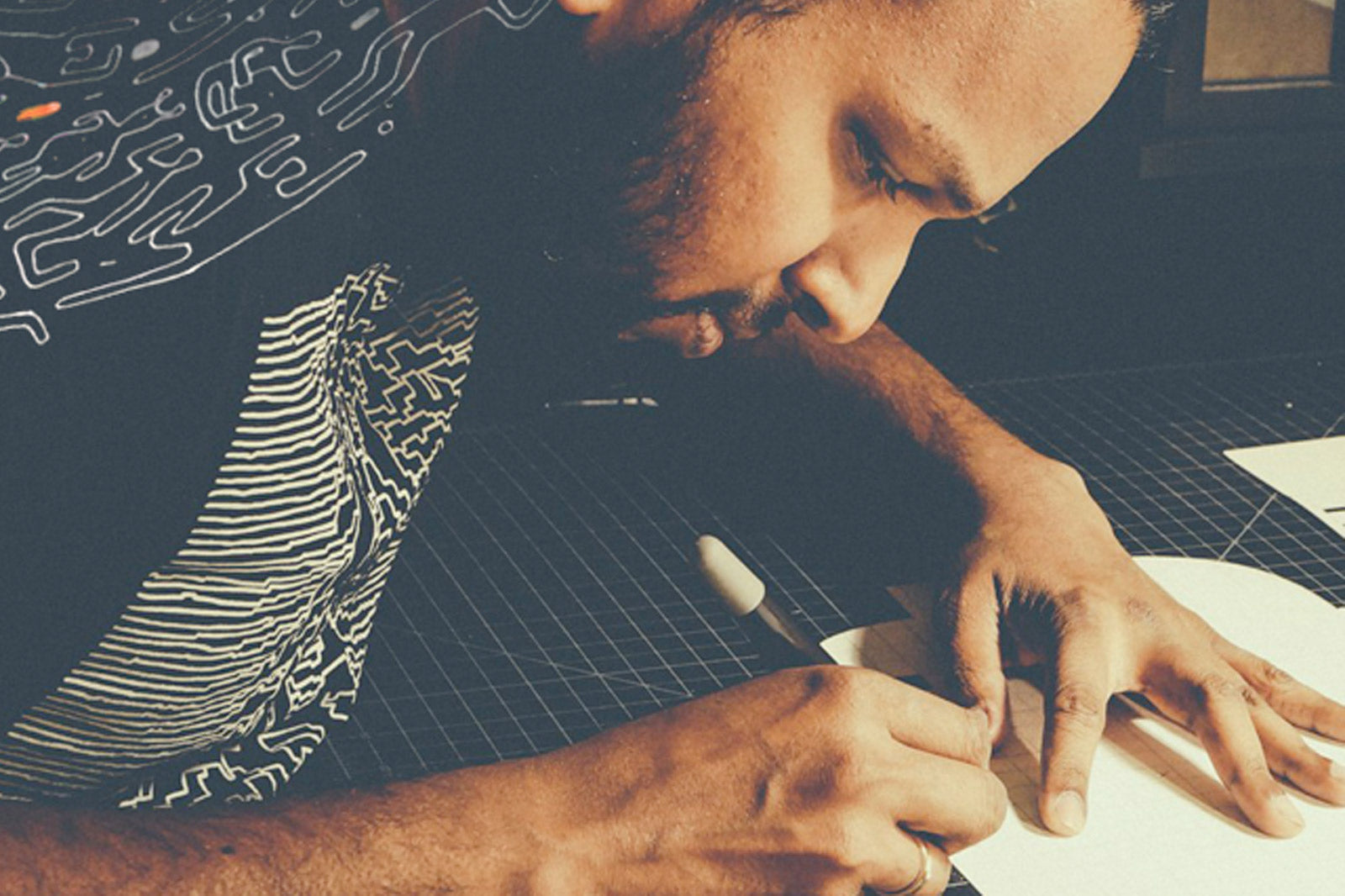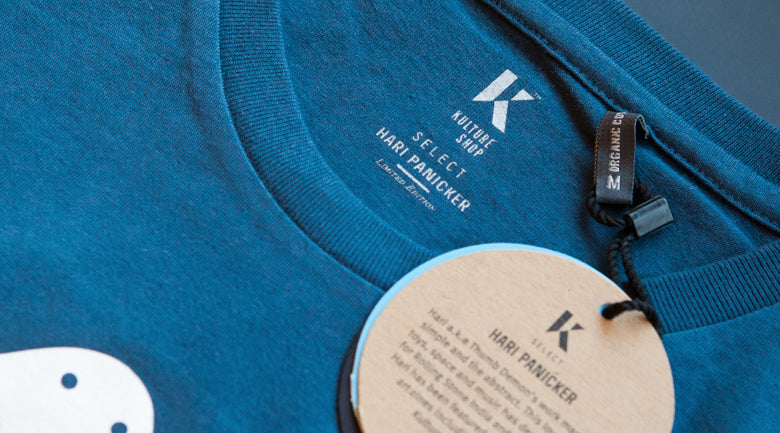Your Cart is Empty
100+ ARTISTS | 1,000+ ARTWORKS | KULTURE SHOP IS NOW CLOSED

Often working in collaboration with wife Deepti Nair, the artist has some incredibly fun names as clients, including MTV, Comedy Central, and even Neil Patrick Harris! Recently back from a long stint in Denver, Hari chats with us on handmade design and working in a long-term collaboration.

Hari and his wife Deepti work on a 125 ft mural for New Belgium Brewery in Denver
Hari: I am (pseudo) Mallu kid, raised in Mumbai in a conventional but creative family. My dad has always been the creative one and he would constantly build things and innovate purely because of necessity and the need to create with what we had. For instance, once we got a carpenter to build a table and he never showed up after the first day, so my dad waited another day and then built the table and chair on his own. So there was always this admiration for him and I was in awe of him since he could build things. He even designed his own house in Kerala. He is my inspiration for everything creative. I was always good at drawing, but never thought of art as a career… and as most South Indian kids do, I went to school for Engineering (talk about stereotypes!). But I realised early on that this was not my calling and post my graduation gathered courage to tell my dad that I wanted to study design. He surprised me by supporting my radical decision and I applied for my IIT entrance.
A young Hari and an all grown up one, wearing his own design for KS, Monsters Within.
Hari: IIT’s IDC (Industrial Design Center) was by far the most crucial experience in my life. I think it made me think as a designer, and be more aware about design, which helped since I don't have a formal art education as such. Also I am a staunch believer of “you are who your friends are” and I was fortunate enough to have some amazing people around me who shaped and influenced how I think and design.

Hari: I like that about being a visual artist. The fact that one idea can be represented in so many ways and mediums. And the more you work on a medium, you get better at it. I never had any formal art education and even though we were exposed to painting and sculpture in IDC, I took to the computer for most of my design needs, until I met Deepti, who is loves traditional and tactile, which eventually rubbed off and I started working with paper. On moving to Denver, we got to explore other styles and mediums. We don’t restrict ourselves to any medium. We love drawing on 2D surfaces to converting our work to 3D and working with paper was liberating. We worked and experimented a lot and it was a long process to developing this style of paper cut sculptures with lights and building fantastical whimsical worlds with them. Denver has been extremely pivotal in all our success. The art community is growing and is really accepting, and we were lucky enough to be there and be a part of it.

Examples of Hari's past work, including a cover for Rolling Stone India and Dualist Inquiry's album art
Hari: When it comes to one particular thread that runs through our work, it would be the idea of exploration. We believe we are all explorers on this planet and we personally learn so much from our travels. The idea of the the unknown road and meeting new people, experiences is the most inviting part of our journey. We also derive a lot from nature, especially the wilderness. Being city bred for most of our lives, we appreciate nature more than ever and frankly I think we can live off the land in the forest, in a small log cabin with a lot of sketch books!

Hari: I am obsessed and intrigued by space. And I think it comes from the realization that we do not know anything about it. So I am constantly intrigued by the idea of space exploration and imagining how it would be in the future. Would it be lonely like the space warrior in Homeward Bound or an astronaut taking a quiet chai break to introspect.



Hari: I started experimenting more after I met my wife Deepti Nair. She loves traditional mediums and working with tactile and physical things. She hates using the computer to design or illustrate and I was the exact opposite. I guess it eventually rubbed off to me and I started working with paper and trying out paints. Our collaborations start with ideas, and that usually happens over travel. We love traveling and taking off on road trips. In that sense we are explorers and that binds us and our work together.

Hari and Deepti working on their massive Globeville Mural
Our styles are very different, but we have a deep understanding of one another’s work and we build off on each other’s strengths. I have a very graphic sense of design and she is more organic and fantastical. I love minimalism and have a knack of simplifying visuals, while she has a keen eye for details and colours. She also tends to experiment more. So we really use all skills to good use. We then sketch out a basic sketch that we improvise and iterate till we are happy with the visual. There are lot of iterations, a lot of fights. (But nothing a great cup of chai can’t solve) and in the end we agree on something that turns out to be far more better than where we started. That's pretty much how we work. Even when we work on our individual projects, we are constantly consulting and critiquing each others work.

Hari: We love paper! And it took us three long years to develop this style of using paper and lights and the ride was totally worth it. The process is long and really intense, but we feel its therapeutic. We start with an idea, a basic doodle of the concept sketch that we draw with all the layers, we are constantly looking at perspective and if the sculpture would have the depth that we need. Once we finalize, we draw out every layer on separate sheets and cut them out by hand. The tough part is understanding how each layer would work in the light and how it affects the depth and perspective.
Bordo Bello NYC // Making of Rise and Skate on Vimeo
Hari: We recently finished a commissioned light box for Neil Patrick Harris which was pretty awesome. He wanted the piece to depict his family and his love for magic. We worked on this 16" x 20" backlit paper sculpture which was a take of the “rabbit in the hat” concept. We also completed a massive 125 ft mural in Denver for New Belgium Brewery celebrating the love for great beer and bikes in beautiful Colorado. Apart from these, I absolutely love working with musicians and have the utmost respect for them. I especially loved working with Dualist Inquiry (Sahej Bakshi) on the album cover for Subterra.

The lightbox commissioned by Neil Patrick Harris, depicting Magic and Family
Hari: I feel the design and art scene has changed tremendously in the last 5 years that I have been away. For starters, art is becoming more accessible and available for everyone who appreciates it and not just the elites. Kulture Shop is definitely in the fore front for making that happen with such an amazing line up of curated artists and collaborations. I have always felt that the Indian scene has a great talent and all it needed a common place to converge and collaborate, and Kulture Shop fills that void. Also Street art is making its presence in a big way. It's the most accessible form of art and also the voice of the people, a great way to express your art. St+Art Delhi and now Mumbai have been great examples of collaborations with local and international artists, and I love how everything is shaping up. These are exciting times to be in India.

Hari's continuing work for Indian music act Dualist Inquiry